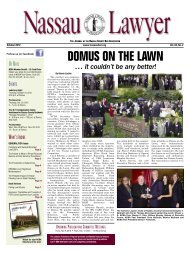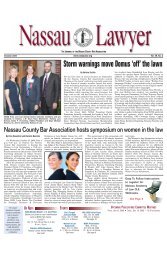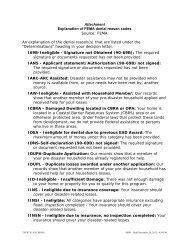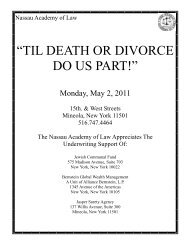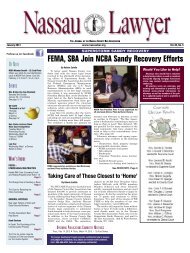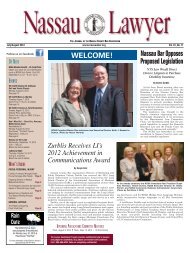394 B.R. 721 Page 16394 B.R. 721, 50 Bankr.Ct.Dec. 192(Cite as: 394 B.R. 721)was not possible to maintain their reputation as leadinglenders to that industry unless they were lenders to MFS"and because "Charles and Matthew Fortgang would notallow MFS to do business with them if they attempted torestrict transfers to Fortgang Affiliates." Furthermore,they believed that they were protected from the adverseconsequences <strong>of</strong> the risky loans through "the personalguaranties <strong>of</strong> Matthew and Charles Fortgang and, subsequently,by obtaining liens on all <strong>of</strong> the assets <strong>of</strong> MFS andFLI." Five <strong>of</strong> the Pre-Petition Banks were also creditors<strong>of</strong> the Fortgang Affiliates, and, benefited directly from theAffiliate Transfers.These allegations amount to no more than an effort tobolster an implausible theory with rank speculation. N<strong>of</strong>acts are <strong>of</strong>fered to support the inference that any particularPre-Petition Bank was so concerned about its lenderreputation in the jewelry business, or what the Fortgangsthought about it, that it would make the types <strong>of</strong> loansnecessary to fund the scheme alleged in the AmendedComplaint. Furthermore, the Amended Complaint doesnot plead any facts to support the contention that the Pre-Petition Banks were willing to make risky loans based onthe Fortgangs' guarantees or liens on unidentified assets.Indeed, if the Fortgang Affiliate receivables were trulyworthless, this would imply that the Fortgang Affiliateswere insolvent, and could not pay their debts. In thatevent, the Fortgangs' equity in the insolvent Fortgang Affiliateswould be worthless, and their ability to honor theirguarantees would be more doubtful. Finally, the fact thatfive unidentified Pre-Petition Banks were also creditors <strong>of</strong>the Fortgang Affiliates and benefited from the AffiliateTransfers implies that these banks made new loans simplyto repay the old loans.In conclusion, the Amended Complaint does not set fortha plausible claim that the Pre-Petition Banks or SPMknew or should have known that the debtors were engagedin a multi-year scheme to make constructivefraudulent transfers <strong>of</strong> the Pre-Petition Bank loans and theSPM gold to the Fortgang Affiliates. Accordingly, thecorresponding obligations to the Pre-Petition Banks arenot avoidable, FLI's guarantee <strong>of</strong> those obligations is notvoidable, and Counts I through III must be dismissed.[FN19] In addition, since the obligations are not avoidable,the liens given to secure the obligations are sup-by antecedent debts, and cannot be avoided. Con-portedsequently, Count IV must also be dismissed.FN19. The Amended Complaint does not supplyany information about the FLI obligations thatMFS guaranteed. Hence, it does not state a claimthat the FLI independent obligations werefraudulent, or that MFS' guarantee <strong>of</strong> those obli-gations was fraudulent.B. Counts V through VII1. The Sufficiency <strong>of</strong> the AllegationsThe last three Counts do not depend on the collapsingdoctrine, or, at least in the first instance, the defendantbanks' knowledge. Counts V and VI allege that betweenJanuary 2006 and the Petition Date, the debtors transferredthe aggregate amount <strong>of</strong> $38,890,000 to four specificFortgang Affiliates: Alpha Diamond, Diamfab,Fabrikant Trading India and Fabrikant HK. During thesame period, the four Fortgang Affiliates transferred$14,025,784 to HSBC, $8,364,295 to ABN and$5,946,592 to IDB. In addition, between January 2005and the Petition Date, the debtors transferred $10,535,000to VSI, another Fortgang Affiliate, and during the sametime span, VSI transferred $9,882,351 to Sovereign Bankin satisfaction *740 <strong>of</strong> its own debt. The Fortgang Affiliatesmade the second set <strong>of</strong> transfers to pay down theirown obligations to the transferee defendant banks. Theplaintiff contends that the first set <strong>of</strong> transfers, from thedebtors to the Fortgang Affiliates, were actually or constructivelyfraudulent. It seeks to avoid these first transfers,and in Count VII, recover the value <strong>of</strong> the transfersfrom the subsequent transferees, HSBC, ABN, IDB andSovereign Bank (collectively, the "Defendant Banks").[FN 20]FN20. Under 11 U.S.C. § 550(b)(1), the trusteecannot recover from a subsequent transferee whotook the transfer for value, in good faith andwithout knowledge <strong>of</strong> the avoidability <strong>of</strong> the initialtransfer. These are affirmative defenses thatthe transferee defendant must plead and prove.Cassirer v. Sterling Nat'l Bank & Trust Co. <strong>of</strong>N.Y. (In re Schick), 223 B.R. 661, 664-65(Bankr.S.D.N.Y.1998).The initial transfers appear to be a subset <strong>of</strong> the transfersthat were indirectly challenged in Counts I through III. Inany case, the allegations relating to the intentional fraudulenttransfer claims are insufficient for the reasons stated,plus a few more. The Amended Complaint fails to identifythe date or amount <strong>of</strong> each transfer. Instead, it aggregatesan indefinite number <strong>of</strong> transfers made during a 2-3year period. Furthermore, except in the case <strong>of</strong> VSI, the© 2009 Thomson Reuters. No Claim to Orig. US Gov. Works.
394 B.R. 721 Page 17394 B.R. 721, 50 Bankr.Ct.Dec. 192(Cite as: 394 B.R. 721)Amended Complaint does not identify which FortgangAffiliate received a particular transfer. Instead, it lumpsthe transfers and the transferees together.The pleading is similarly vague in alleging the second set<strong>of</strong> transfers to the Defendant Banks. The Amended Complaintdoes not specify the dates or amounts <strong>of</strong> the transfers.Except for VSI, it also fails to identify which <strong>of</strong> theother four Fortgang Affiliates made a particular transfer,and who among the Defendant Banks received that transfer.Instead, it lumps the transfers, the transferors andtransferees together. Accordingly, claims that the initialtransfers were made with actual fraudulent intent fail, andthe plaintiff cannot recover those transfers from a subse-quent transferee.Conversely, the allegations regarding constructivefraudulent transfers are sufficient, again for the reasonsstated. The Court has already addressed the allegations <strong>of</strong>constructive fraudulent transfers from the debtors to theFortgang Affiliates. These are sufficient to state a claimfor avoidance. The Amended Complaint also alleges thatthe four Fortgang Affiliates retransferred the initial transfersto the four Defendant Banks. The allegations providethe Defendant Banks with notice <strong>of</strong> the plaintiff's claims,and permit them to defend the action. Accordingly, theclaims to recover the constructive fraudulent transfersfrom the Defendant Banks, as subsequent transferees, arelegally sufficient.2. The Failure to Join The Fortgang AffiliatesAlthough Counts V through VII seek to avoid the transfersby the debtors to the five Fortgang Affiliates, theplaintiff did not join these or any Fortgang Affiliates asdefendants. The Court raised the question and invitedbriefing on whether the § 550(a) action could proceed intheir absence. This is a variation <strong>of</strong> a frequently asked and<strong>of</strong>ten debated point: can a trustee recover under § 550(a)from a subsequent transferee without first avoiding thetransfer in a suit against the initial transferee. I concludethat under the circumstances alleged in the AmendedComplaint, the plaintiff can bypass the Fortgang Affiliatesand proceed directly against the Defendant Banks.*741 a. The Bankruptcy Code[18][19] The Bankruptcy Code separates the concepts <strong>of</strong>avoidance and recovery. Levit v. Ingersoll Rand Fin.Corp. (In re VN Deprizio Constr. Co.), 874 F.2d 1186,1196 (7th Cir.1989); Savage & Assocs., P.C. v. BLRServs. SAS (In re Teligent, Inc.), 307 B.R. 744, 749(Bankr.S.D.N.Y.2004); HR Rep No. 95-595 at 375(1977), U.S.Code Cong. & Admin.News, 1977 pp. 5963,6331 ("[S]ection 550 prescribes the liability <strong>of</strong> a transferee<strong>of</strong> an avoided transfer, and enunciates the separationbetween the concepts <strong>of</strong> avoiding a transfer and recoveringfrom the transferee."); S Rep No. 95-989 at 90(1978)(same). Several sections permit a trustee to avoid atransfer on the ground that it is fraudulent. See, e.g., 11U.S.C. §§ 544(b), 548. Sometimes, this is all the relief thetrustee needs. For example, if a trustee challenges thegranting <strong>of</strong> a mortgage, and the court avoids the mortgageas a fraudulent transfer, the declaration <strong>of</strong> voidness endsthe litigation--the trustee does not need to "recover" themortgage.More <strong>of</strong>ten, however, the trustee will seek affirmativerecovery beyond a judicial declaration <strong>of</strong> voidness. Forexample, if the debtor fraudulently transferred a piece <strong>of</strong>personal property, the trustee will seek to avoid the transferand recover the personal property or its value. Similarly,if the debtor fraudulently transferred cash and thetrustee avoids the transfer, he will want to recover thesame amount <strong>of</strong> cash.Section 550 deals with the situations involving affirma-recovery. Section 550(a) states:tiveExcept as otherwise provided in this section, to the extentthat a transfer is avoided under section 544, 545,547, 548, 549, 553(b), or 724(a) <strong>of</strong> this title, the trusteemay recover, for the benefit <strong>of</strong> the estate, the propertytransferred, or, if the court so orders, the value <strong>of</strong> suchproperty, from ... the initial transferee <strong>of</strong> such transferor the entity for whose benefit such transfer was made;or any immediate or mediate transferee <strong>of</strong> such initialtransferee.(emphasis added). As noted, the debate generated by theemphasized language is whether the trustee must firstavoid a transfer as between the initial transferor and trans-before he can recover from the subsequent trans-feree,feree.[20] The starting point for the construction <strong>of</strong> any statuteis the plain language <strong>of</strong> the statute itself. United States v.Ron Pair Enters., 489 U.S. 235, 242, 109 S.Ct. 1026, 103L.Ed.2d 290 (1989)("The plain meaning <strong>of</strong> legislationshould be conclusive, except in the 'rare cases [in which]the literal application <strong>of</strong> a statute will produce a resultdemonstrably at odds with the intentions <strong>of</strong> its drafters.'")(internal citation omitted). The meaning <strong>of</strong> "to the extentavoided" is apparent. "Avoid" is a verb that means"[t]o render void, BLACK'S LAW DICTIONARY 146© 2009 Thomson Reuters. No Claim to Orig. US Gov. Works.
- Page 1 and 2:
Nassau Academy of LawCLE Live Class
- Page 3 and 4:
McKinney's Debtor and Creditor Law
- Page 5 and 6:
McKinney's Debtor and Creditor Law
- Page 7 and 8:
McKinney's Debtor and Creditor Law
- Page 9 and 10:
McKinney's Debtor and Creditor Law
- Page 11 and 12:
McKinney's Debtor and Creditor Law
- Page 13 and 14:
McKinney's Debtor and Creditor Law
- Page 15 and 16:
McKinney's Debtor and Creditor Law
- Page 17 and 18:
McKinney's Debtor and Creditor Law
- Page 19 and 20:
BAKER & HOSTETLER LLP45 Rockefeller
- Page 21 and 22:
usiness of defendant Bernard L. Mad
- Page 23 and 24:
BACKGROUND, THE TRUSTEE, AND STANDI
- Page 25 and 26:
Madoff who received fraudulent tran
- Page 27 and 28:
ased on fictitious profits and for
- Page 29 and 30:
28. BLMIS funds were also used to p
- Page 31 and 32:
Madoff, and her niece, Shana Madoff
- Page 33 and 34:
42. Ruth Madoff was never an employ
- Page 35 and 36: FIRST CAUSE OF ACTIONTURNOVER AND A
- Page 37 and 38: 66. At the time of each of the Two-
- Page 39 and 40: Transfers; (b) directing that the S
- Page 41 and 42: EIGHTH CAUSE OF ACTIONUNDISCOVERED
- Page 43 and 44: TENTH CAUSE OF ACTIONDISALLOWANCE O
- Page 45 and 46: 111. Mrs. Madoff benefited from the
- Page 47 and 48: WHEREFORE, the Trustee respectfully
- Page 49 and 50: 2(c)(3): (a) preserving the Subsequ
- Page 51 and 52: 302 B.R. 760 Page 1302 B.R. 760(Cit
- Page 53 and 54: 302 B.R. 760 Page 3302 B.R. 760(Cit
- Page 55 and 56: 302 B.R. 760 Page 5302 B.R. 760(Cit
- Page 57 and 58: 302 B.R. 760 Page 7302 B.R. 760(Cit
- Page 59 and 60: 302 B.R. 760 Page 9302 B.R. 760(Cit
- Page 61 and 62: 302 B.R. 760 Page 11302 B.R. 760(Ci
- Page 63 and 64: 302 B.R. 760 Page 13302 B.R. 760(Ci
- Page 65 and 66: 302 B.R. 760 Page 15302 B.R. 760(Ci
- Page 67 and 68: 302 B.R. 760 Page 17302 B.R. 760(Ci
- Page 69 and 70: 302 B.R. 760 Page 19302 B.R. 760(Ci
- Page 71 and 72: 394 B.R. 721 Page 1394 B.R. 721, 50
- Page 73 and 74: 394 B.R. 721 Page 3394 B.R. 721, 50
- Page 75 and 76: 394 B.R. 721 Page 5394 B.R. 721, 50
- Page 77 and 78: 394 B.R. 721 Page 7394 B.R. 721, 50
- Page 79 and 80: 394 B.R. 721 Page 9394 B.R. 721, 50
- Page 81 and 82: 394 B.R. 721 Page 11394 B.R. 721, 5
- Page 83 and 84: 394 B.R. 721 Page 13394 B.R. 721, 5
- Page 85: 394 B.R. 721 Page 15394 B.R. 721, 5
- Page 89 and 90: 394 B.R. 721 Page 19394 B.R. 721, 5
- Page 91 and 92: 394 B.R. 721 Page 21394 B.R. 721, 5
- Page 93 and 94: 397 B.R. 642 Page 2397 B.R. 642(Cit
- Page 95 and 96: 397 B.R. 642 Page 4397 B.R. 642(Cit
- Page 97 and 98: 397 B.R. 642 Page 6397 B.R. 642(Cit
- Page 99 and 100: 397 B.R. 642 Page 8397 B.R. 642(Cit
- Page 101 and 102: 397 B.R. 642 Page 10397 B.R. 642(Ci
- Page 103 and 104: 397 B.R. 642 Page 12397 B.R. 642(Ci
- Page 105 and 106: 397 B.R. 642 Page 14397 B.R. 642(Ci
- Page 107 and 108: 443 F.3d 180 Page 2443 F.3d 180(Cit
- Page 109 and 110: 443 F.3d 180 Page 4443 F.3d 180(Cit
- Page 111 and 112: 443 F.3d 180 Page 6443 F.3d 180(Cit
- Page 113 and 114: 443 F.3d 180 Page 8443 F.3d 180(Cit
- Page 115 and 116: 443 F.3d 180 Page 10443 F.3d 180(Ci
- Page 117 and 118: 443 F.3d 180 Page 12443 F.3d 180(Ci
- Page 119 and 120: Page 2257 A.D.2d 526, 684 N.Y.S.2d
- Page 121 and 122: Page 4257 A.D.2d 526, 684 N.Y.S.2d
- Page 123 and 124: Page 6257 A.D.2d 526, 684 N.Y.S.2d
- Page 125 and 126: 770 N.Y.S.2d 421 Page 22 A.D.3d 780
- Page 127 and 128: Page 14 A.D.3d 495, 773 N.Y.S.2d 71
- Page 129: Page 34 A.D.3d 495, 773 N.Y.S.2d 71
- Page 132 and 133: 780 N.Y.S.2d 409 Page 29 A.D.3d 553
- Page 134 and 135: Page 134 A.D.3d 231, 824 N.Y.S.2d 3
- Page 136 and 137:
Page 334 A.D.3d 231, 824 N.Y.S.2d 3
- Page 138 and 139:
Page 2991 F.2d 31(Cite as: 991 F.2d
- Page 140 and 141:
Page 4991 F.2d 31(Cite as: 991 F.2d
- Page 142 and 143:
Page 6991 F.2d 31(Cite as: 991 F.2d
- Page 144 and 145:
FRAUDULENT TRANFERENCESRonald M. Te
- Page 146 and 147:
Nursing home case_ Transfer of pers
- Page 148 and 149:
Sections 548 and 544 work in concer
- Page 150 and 151:
U.S. Supreme CourtBFP v. Resolution
- Page 152 and 153:
example, from net 15 to COD; or cha
- Page 154 and 155:
Bankruptcy Code Section§ 548. Frau
- Page 156:
Ron Terenzi is a founding partner a



